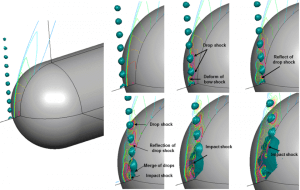(Huntsville, Ala. | March 17, 2020) – CFD Research Corporation announced today the award of a Small Business Innovative Research (SBIR) Phase II contract from NAVAIR to develop and validate a first-principles based, high-fidelity multiphase CFD tool to predict raindrop distortion and demise in the flow field around a missile in supersonic flight. This tool will be used by the Navy to understand both the impact event and the associated material damage mechanisms.
 “The requirement of all-weather capability for high-speed aircraft, launch vehicles, rockets, and missiles has made the protection of these systems from rain erosion a vital design factor,” said Dr. H.Q. Yang, CFD Research chief scientist and principal investigator on this project. “The primary benefit of this work will be the development of an efficient, full physics model that can accurately simulate multiphase, compressible flows for determining water droplet distortion and demise for supersonic missions.”
“The requirement of all-weather capability for high-speed aircraft, launch vehicles, rockets, and missiles has made the protection of these systems from rain erosion a vital design factor,” said Dr. H.Q. Yang, CFD Research chief scientist and principal investigator on this project. “The primary benefit of this work will be the development of an efficient, full physics model that can accurately simulate multiphase, compressible flows for determining water droplet distortion and demise for supersonic missions.”
Droplet-shock interaction can have many different effects on the flow field around a high-speed vehicle and corresponding effects on vehicle performance. Droplets passing through a shock can cause pressure changes which will modify the shape of the shock. This will alter the aerodynamics of the vehicle until the shock returns to its normal position. More concerning, however, is the impact on the shape of the droplet, its distortion, and potential demise before impacting the body of the vehicle and the potential for damaging the vehicle’s surface material.
The highly accurate and scalable tool being developed in this project will be used to perform parametric studies for a number of conditions representative of real-flight missile forebodies and aircraft to better understand the effects on the droplet-shock interaction for a range of conditions. CFD Research has partnered with Engineering & Scientific Innovations (ESI) to perform experiments to characterize the drop shape at terminal velocity and measure the raindrop distortion with the shock wave and flow field in front of a traveling projectile. That data will be further used for validation and refinement of the simulation tool.
“This simulation tool will be highly valuable for many government agencies including the U.S. Army, Air Force, Navy, and NASA when making flight decisions under adverse weather conditions,” noted Sami Habchi, CFD Research executive vice-president. “In addition, future commercial interest is likely as commercial companies continue to pursue high-speed flight, orbital launches, and reentry.”
 About CFD Research: Since its inception in 1987, CFD Research has worked with government agencies, businesses and academia to provide innovative solutions within the Aerospace & Defense, Biomedical & Life Sciences, and Energy & Materials industries. Over the years CFD Research has earned multiple national awards for successful application and commercialization of innovative component/system technology prototypes, multi-physics simulation software, multi-disciplinary analyses, and expert support services. CFD Research is an ISO9001 and AS9100 registered company and is appraised at CMMI Level II for services. Learn more at www.cfdrc.com.
About CFD Research: Since its inception in 1987, CFD Research has worked with government agencies, businesses and academia to provide innovative solutions within the Aerospace & Defense, Biomedical & Life Sciences, and Energy & Materials industries. Over the years CFD Research has earned multiple national awards for successful application and commercialization of innovative component/system technology prototypes, multi-physics simulation software, multi-disciplinary analyses, and expert support services. CFD Research is an ISO9001 and AS9100 registered company and is appraised at CMMI Level II for services. Learn more at www.cfdrc.com.
This material is based upon work supported by the Naval Air Warfare Center Weapons Division, China Lake, CA under Contract No. N6893620C0035. Any opinions, findings and conclusions or recommendations expressed in this material are those of the author(s) and do not necessarily reflect the views of the Naval Air Warfare Center Weapons Division, China Lake, CA.






